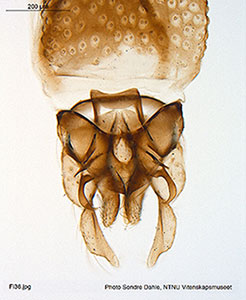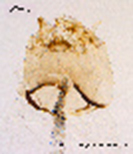Species 5s. C. islandicus (Kieffer, 1913)Some specimens identified as C. islandicus from Iceland and also from North America. This is the first indication that this species may occur in the Nearctic, but unfortunately no morphological data are given. The nearest neighbor is C. sp. h in BOLD Bin: BOLD:AAP3010 Adult similar to C. hyperboreus. The species was redescribed by Pedersen (1978) along with the cytology. Wülker and Butler (1983) also described the polytene chromosome sequences and some larval characters and Stur and Ekrem (2020) gave further information on the adults and some photographs of some larval characters. Wing length 4.9 (3.7-5.5) mm. AR 5.0 (4.5-5.5); LR1 1.12 (1.06-1.17); LR2 0.58 (0.53-0.60); LR3 0.67 (0.62-0.72). BR 5.7 (5.1-6.3). Head black. Thorax with black ground color, with pruinose areas on antero-lateral and posterior-median parts of scutum and some pruiescense on the pleural sclerites. Scutellum and postnotum black, halteres dirty white. Thoracic setae: acrostichal 21 (13-34), dorsolaterals 58 (34-84), prelars 12 (8-16). Legs black-brown with tarsal segments a little paler.  Male hypopygium of C. islandicus (BOLD Fi36+1346868292) Abdomen black, posterior margins of segments paler. TIX with about 9 setae in individual pale spots. Female: Not described. Pupa: (From Langton & Visser 2003): Exuvial length 9.0-12.0 mm. Fourth instar larva: (From Wülker & Butler 1983) a salinarius-type, although small humps may be present at rear of segment XI.  BOLDBJ149-556 Mentum width about 140 µm, with central tooth type IIA; 4th lateral not reduced (type I). Pecten epipharyngis with about 8 teeth; mandible with third inner tooth separated and partly colored (type IIIB); MTR about 0.27 Cytology: Four polytene chromosomes with the thummi arm combination AB, CD, EF, G. isl B1: Nucleolus proximal in arm B, banding unclear. isl C1: 1 - 6b, 15c-e, 8 - 11c, 15b - 11d, 6gh, 17a - 16, 7d-a, 6f-c, 17b - 22 i.e. as cucini, sp. 3b. isl D1: distal bands identical to those of tardus, cucini, cucini, mangnus, but unspecified changes nearer the centromere. isl E1: possibly 1 - 3e, 5 - 10b, 4 - 3f, 10c - 13 but difficult to be certain due to the 2 nucleoli i.e. possibly as aberratus, tardus, cucini, hyperboreus, sp. h, etc. isl F1: possibly 1-10, 17-11, 18-23 i.e. as cucini, tenuistylus, tardus, etc. Found: Nunavut - Kitikmeot (69.2187°N, 104.926°W) (BOLD) The cytology indicates that this species is clearly closely related to a group of northern species, such as C. hyperboreus, C. cucini, C. magnus (Wülker & Butler 1983) and C. species h, as all have heterochromatic centromeres and a small arm G and most with multiple nucleoli in the long chromosomes, some of which appear to correspond. As well, the males of both species have a similar Superior volsella. The adult is very similar in coloration to C. hyperboreus, but can be differentiated by the lower LR. Modified: 15 March 2023 Access: Unrestricted Copyright © 2021-2023, Jon Martin. |